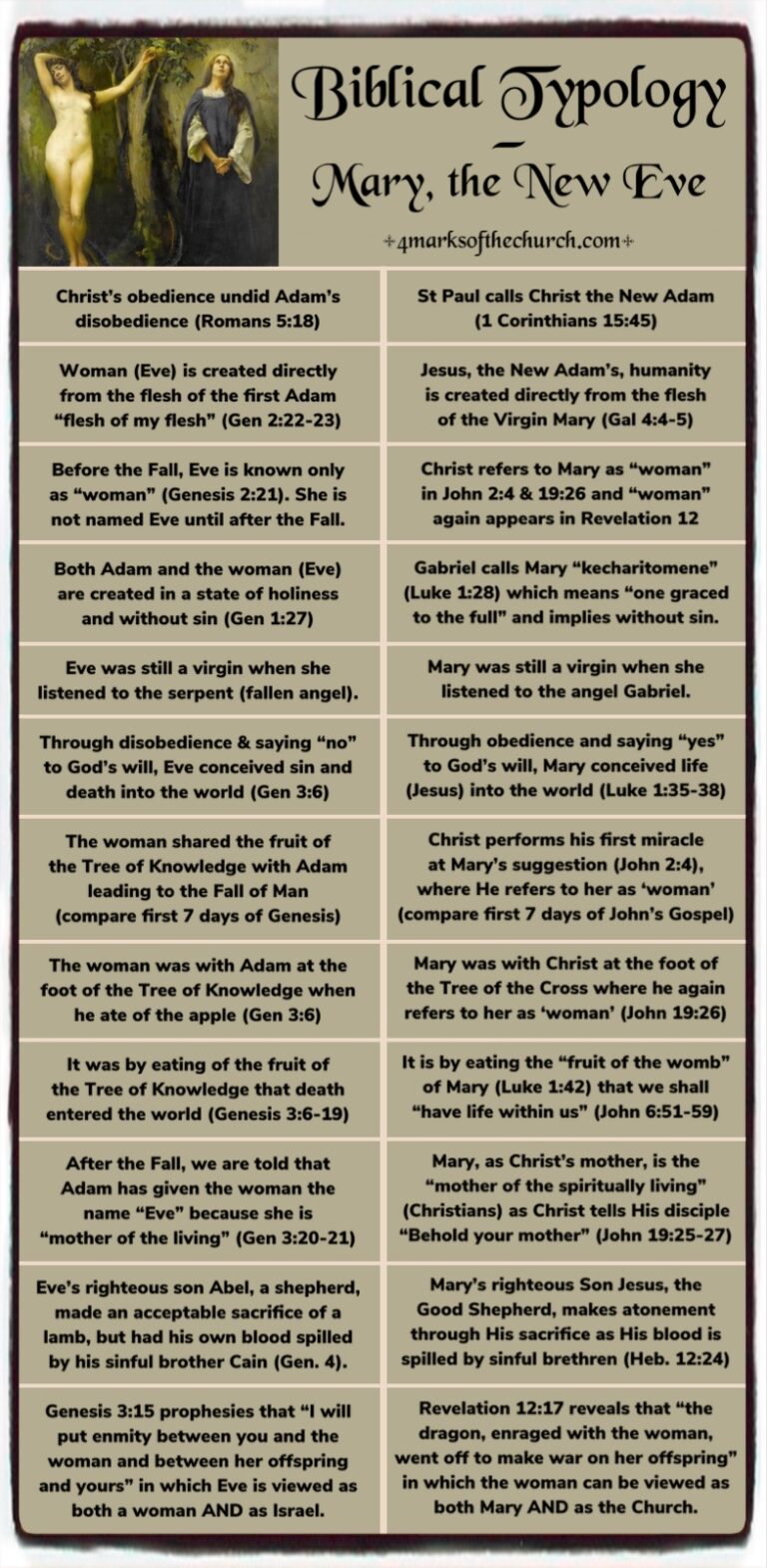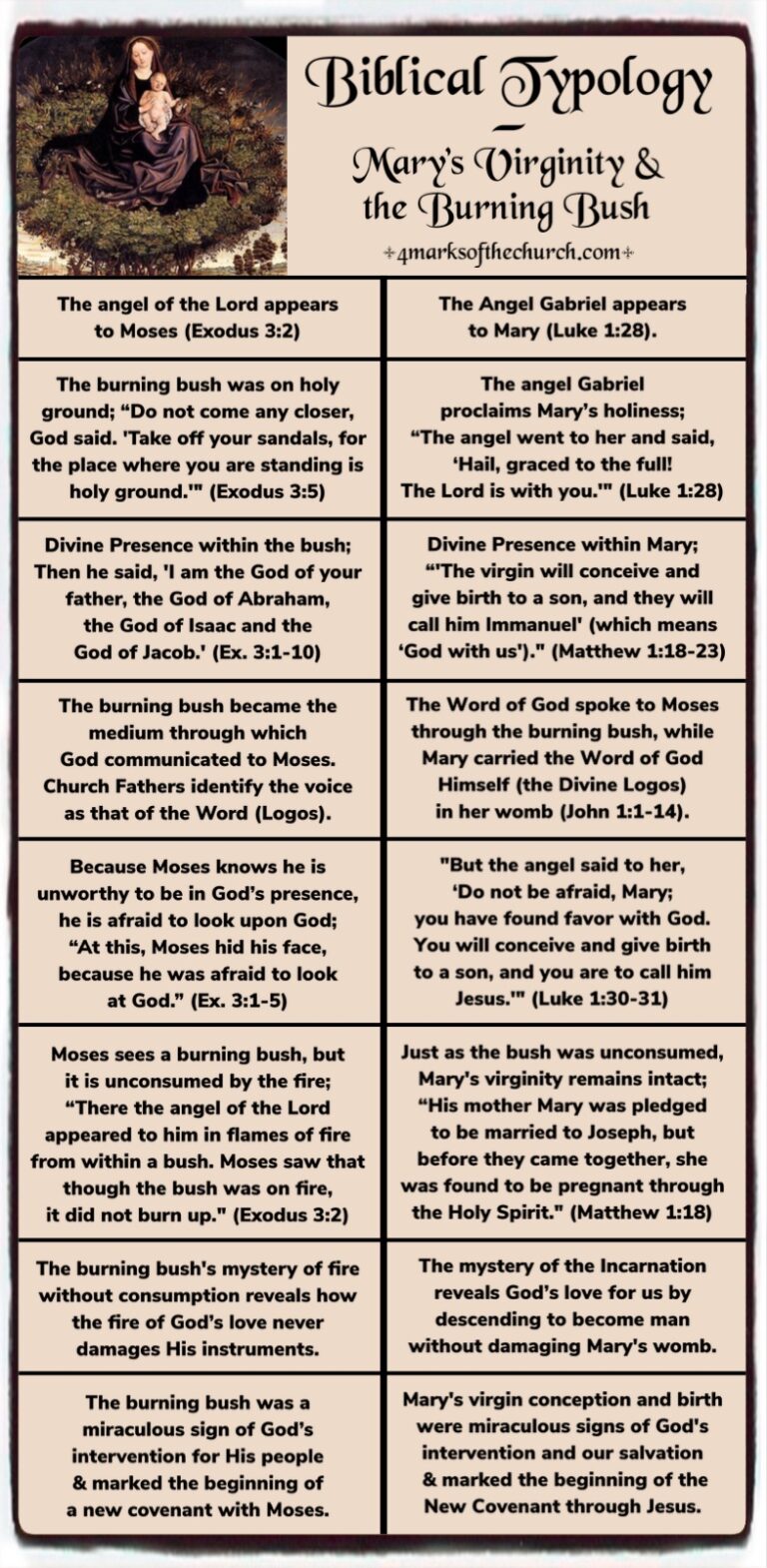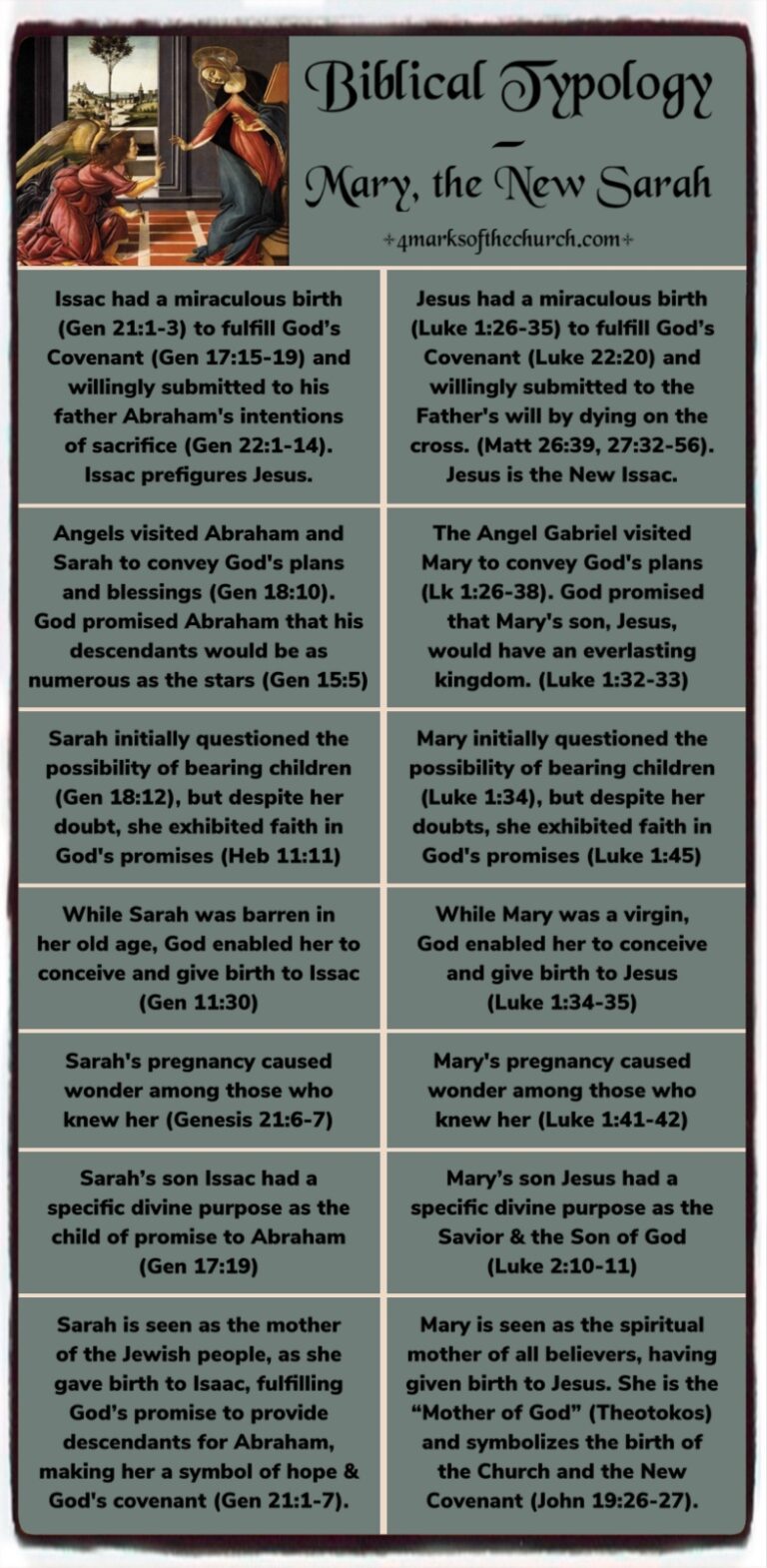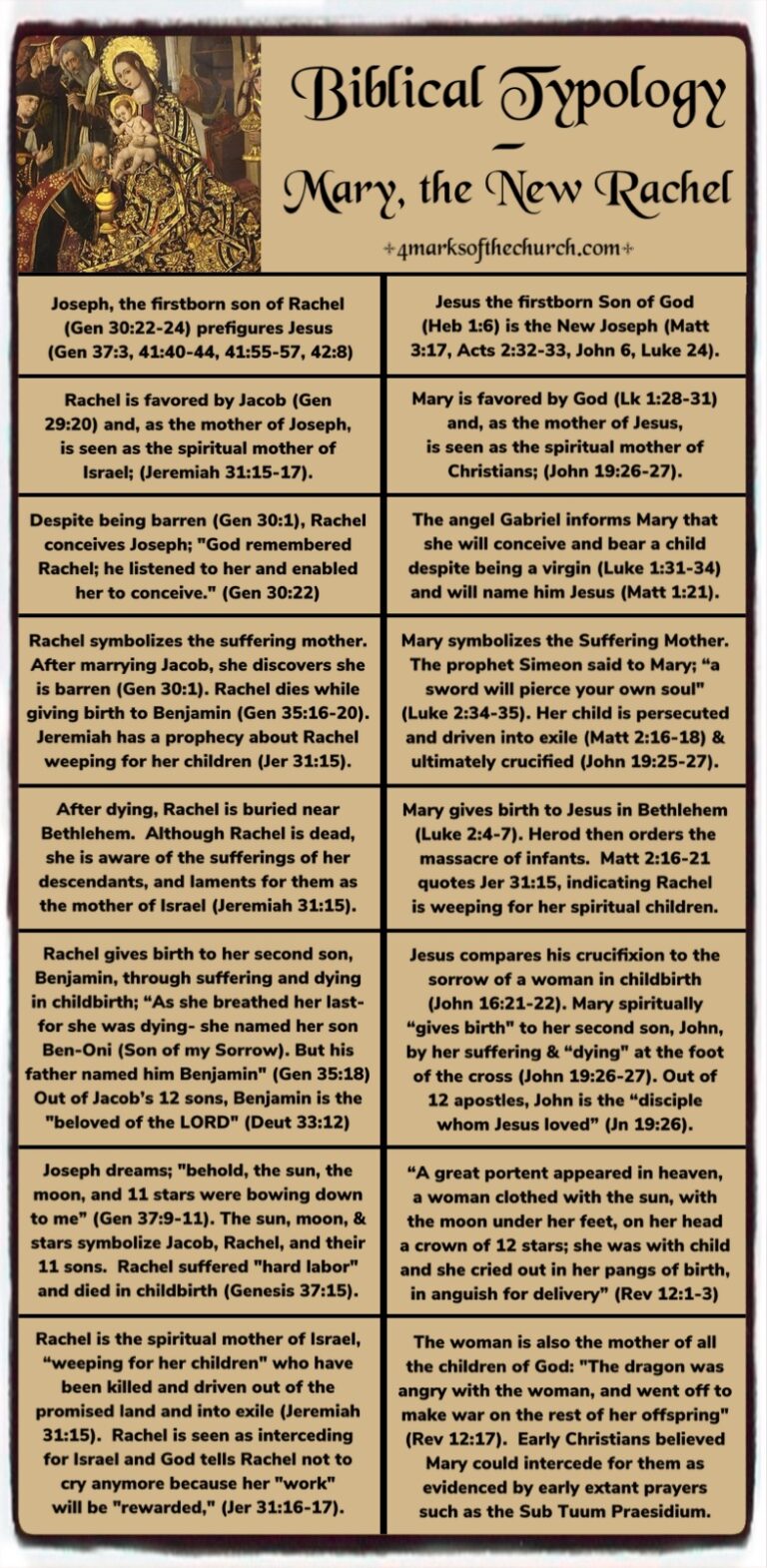
Biblical Typology;
Relationship of the Old Testament to the New
Definition of Terms:
|
For over 2000 years, Christians have pondered the relationship of the Old Testament to the New. Some modern scholars have proposed “Replacement Theology”; the theological conviction that the Christian Church has superseded the nation of Israel assuming their role as God’s covenanted people. This would seem to contradict Christ’s own words, however, when he says; “I have not come to abolish the law or the prophets, but to fulfill them” (Matt’s 5:17). The tendency of the Church Fathers was to instead turn to typology, as Augustine of Hippo said; “the New Testament lies hidden in the Old and the Old Testament is revealed in the New” (-Commentary on the Sermon on the Mount). Biblical Typology is a literary device used in the Bible where characters, events, or objects are seen as prefigurations or foreshadowings of future events or figures. Typology is a way to understand and interpret the Bible’s overarching narrative and the relationship between the Old and New Testaments. It involves the use of symbolic language and narrative to convey deeper meanings and truths. Biblical typology does not deny the literal sense that the author intended, but is an allegorical method used to help highlight the continuity and purpose in God’s plan. This allows for multiple layers of interpretation and invites readers to explore the text beyond its literal sense.
The concept of reading the Old Testament in a way other than it’s strict literal sense has it’s origins in Pre-Christian Judaism, but is a practice that Christ Himself seems to have taken up in the New Testament. An example being in Matt 19:1-8 when the Pharisees ask Jesus about divorce and Jesus reinterprets the law to say that it was because of their hardness of heart that Moses allowed it. Christ again seems to reinterpret Scripture when he is asked about the return of Elijah prophesied in Malachi 4:5-6, which Jesus replies has been fulfilled by John the Baptist (Matt 17:10-13). This is not only an allegory, but a direct use of Typology by Christ. This reinterpretation of Scripture by Christ would seem to culminate on the road to Emmaus, when Jesus walks with two of his disciples and,
“beginning with Moses and all the prophets, he interpreted to them in all the scriptures the things concerning himself” (Luke 24:27).
Paul the Apostle would further develop the practice of reading the Old Testament allegorically in his letters. Paul had once taken commandments such as stoning Sabbath breakers (Exodus 31:14-15, Numbers 15:32-36), literally, but would now proclaim in 2 Cor. 3:6 that it is the Spirit that gives life while the letter leads to death. He would go on to refer explicitly to Typology in Colossians 2:16–17:
“Therefore do not let anyone judge you by what you eat or drink, or with regard to a religious festival, a New Moon celebration or a sabbath day. These are a shadow of the things that were to come; the reality, however, is found in Christ.”
In Romans 5:14, Paul calls Adam “a type [τύπος] of the one who was to come” —i.e., a type of Christ. He would also contrast Adam and Christ in 1 Corinthians 15. We even see Paul take a new, explicitly allegorical, interpretation of Abraham, Hagar, and Sarah:
“Tell me, you who want to be under law, do you not listen to the Law? For it is written that Abraham had two sons, one by the slave woman and one by the free woman. But the son by the slave woman was born according to the flesh, and the son by the free woman through the promise. This is speaking allegorically, for these women are two covenants” (Gal. 4:22-24).
Paul would also take an allegorical interpretation of the parting of the Red Sea in Exodus 14. In addition to the literal text, he also saw a prefigurement of baptism; “our fathers were all under the cloud, and all passed through the sea, and all were baptized into Moses in the cloud and in the sea” (1 Cor. 10:1-2). Other Biblical authors would follow suit as the author of the First Epistle of Peter uses the term ἀντίτυπον (antitypon) to refer to Noah’s flood as prefiguring baptism (1 Peter 3:21).
New Testament Authors:
There are examples of typology throughout the New Testament. The offering of Isaac in Genesis 22 prefigures Christ’s cruicifixion; God asks Abraham to offer his son Isaac to Him, Isaac asks his father, “Where is the lamb for the burnt offering”, and Abraham prophesies, “God himself will provide the lamb for the burnt offering, my son.” A ram caught by its horns is then revealed to them, which is also seen as a type for Christ, the lamb that God, crowned by thorns and sacrifices Himself on the cross. Jonah’s three days in the belly of a whale has been said to prefigure Jesus Christ’s three days in the tomb (Matt. 12:38-42). Melchizedek’s offering of bread and wine (Gen. 14:17-20) prefigures Jesus’ offering of his body and blood, soul and divinity under the appearances of bread and wine in the New Covenant (Matt. 26:26-28; Heb. 5:7-10). In addition to Adam, Moses and other Old Testament figures have been said to prefigure Christ. Joseph (Genesis Chapters 37–50) is commonly cited as a Christ type. Parallels between Joseph and Jesus include:
- both are rejected by their own people
- both became servants
- both are betrayed for silver
- both are falsely accused and face false witnesses
- both attain stations at the “right hand” of the respective thrones (Joseph at Pharaoh’s throne and Christ at the throne of God)
- both provided for the salvation of gentiles, (Joseph provided a physical salvation in preparing for the famine, while Christ provided the deeper spiritual salvation)
- A direct parallel with Joseph ruling over all of Egypt, and that only Pharaoh would be greater in the throne (Genesis 41:40) is repeated in 1 Corinthians 15:27 with regards to Jesus
- Both suffered greatly, and through patience and humbleness were exalted greatly by God, who gave in abundance all things over time.
Other examples include:
Old Testament Authority Figures Foreshadowing of Peter’s Authority:
Authority of O.T. Religious Figures | Authority Given to Peter by Christ |
A new name meant a change in status for that person: Abram’s name changed to Abraham (Gen 17:5), Jacob’s to Israel (Gen 32:28). | Christ calls Simon “Cephas” (John 1:42), which is the Greek transliteration of the Aramaic word “Kepha” meaning “rock”. Paul refers to Peter as “Cephas” in 1 Cor. 1:12, 3:22 & Gal. 1:18, 2:9. |
Abraham is the rock from which Israel is hewn (Isaiah 51:1-2): “Look to the rock from which you were cut and to the quarry from which you were hewn; look to Abraham, your father.” | “Peter” is the rock on which the Church would be built (Matt 16:18). “Petra” in Koine Greek = “rock”; as a feminine noun, it must be changed to “petros” since Peter was a man. Greek for “stone” = “lithos”. |
Eliakim is given authority; “On that day I will summon my servant Eliakim son of Hilkiah, . . . I will commit your authority to his hand and he shall be a father to the inhabitants of Jerusalem” (Is 22:21) | Peter & the apostles are given authority; “Then He summoned his twelve disciples and gave them authority. . . The names of the twelve apostles are these: first Simon called Peter…” (Matt. 10:1-2). |
Eliakim is the peg which will hold up the tent of the Kingdom of Israel; “I will fasten him like a peg in a secure place and he will become a throne of honor to his ancestral house” (Is. 22:23). | Peter is the rock on which the church is built; “I tell you, you are Peter (“rock”), and on this rock I will build my church, and the gates of Hell will not prevail against it” (Matt 16:18) |
Eliakim, as steward, is given the keys to the kingdom; “I will place on his shoulder the key of the house of David; what he shall open, no one shall shut; what he shall shut, no one shall open” (Is. 22:22). Giving the “keys to the city” is a symbol of authority in the king’s absence. | Peter, as steward, is given the keys to the kingdom; “I will give you the keys of the kingdom of heaven, and whatever you bind on earth will be bound in heaven, and whatever you loose on earth, will be loosed in heaven” (Matt. 16:19). Peter has been given jurisdiction on earth. |
Although Reuben was the firstborn of Israel, it is his brother Joseph who is treated as the firstborn among the 12 sons of Israel (1 Chron 5:1, Gen 37:3-4). Joseph would be made vizier (prime minister) by Pharaoh in Egypt (Gen 41:33-40). | Although Andrew is the first Apostle called by Christ (John 1:40-42), it is his brother Peter who will have Primacy (Matt 10:1-4, Mark 3:16-19, Luke 12:41) among the 12 apostles. Peter would be made steward (prime minister) by Christ (Matt 16:19) |
In the O.T. the metaphor of shepherd is portrayed with leadership; Abraham (Gen 13:2), Joseph (Gen 37:2), Moses (Ex 3:1-3), and David (1 Sam 16:11) were shepherds and the people of Israel were their sheep (Ez 34). | Jesus Christ is the Good Shepherd (John 10:11, 14). Before His Ascension, He places Peter in charge of His earthly flock in a 3-fold manner; “Feed my lambs”, “Tend my sheep”, “Feed my sheep” (John 21:15-17) |
The promises to Abraham were 3-fold; Land Descendants, and Blessings | Peter’s authority would also be 3-fold; Rock, Steward, and Shepherd |
The Seat of the Ancestral House (Isaiah 22:22) and the Seat of Moses (Matt 23:2-3) were Jewish symbols of authority. | Early Christians such as Tertullian referred to Papal authority as the “Chair of Peter.” Latin for “chair” = “cathedra” |
Eve’s Foreshadowing of Mary:
Woman, the First Eve | Mary, the New Eve |
Christ’s obedience undid Adam’s disobedience (Romans 5:18) | St. Paul calls Christ the New Adam (1 Corinthians 15:45) |
Woman (Eve) is created directly from the flesh of the first Adam; “flesh of my “flesh” (Gen 2:22-23) | Jesus, the New Adam’s, humanity is created directly from the flesh of the Virgin Mary (Gal 4:4-5) |
Before the Fall, Eve is only known as “woman” (Genesis 2:21). She is not named Eve until after the Fall. | Christ refers to His mother as “woman” in John 2:4 and John 19:26 and “woman” again appears in Revelation 12 |
Both Adam and the woman (Eve) are created in a state of holiness and without sin (Gen 1:27) | The angel Gabriel addresses Mary as “kecharitomene” (Luke 1:28) which means “one who has been graced to the full” and implies without sin. |
The woman (Eve) was still a virgin when she listened to the serpent (a fallen angel). | Mary was still a virgin when she listened to the angel Gabriel. |
Through disobedience and saying “no” to God’s will, the woman conceived sin and death into the world (Gen 3:6) | Through obedience and saying “yes” to God’s will, Mary conceived life (Jesus) into the world (Luke 1:35-38) |
The woman shared the fruit of the Tree of Knowledge with Adam leading to the Fall of Man (compare first 7 days of Genesis) | Christ performs his first miracle at Mary’s suggestion (John 2:4), who he refers to as ‘woman’ (compare the first 7 days of John’s Gospel) |
The woman was with Adam at the foot of the Tree of Knowledge when he ate the apple (Gen 3:6). | Mary was with Christ at the foot of the Tree of the Cross where he again refers to her as ‘woman’ (John 19:26) |
It was by eating of the fruit of the Tree of Knowledge that death entered the world (Genesis 3:6-19) | It is by eating the “fruit of the womb” of Mary (Luke 1:42) that we shall “have life within us” (John 6:51-59) |
After the Fall, we are told that Adam has given the woman the name “Eve” because she is “mother of the living” (Genesis 3:20-21) | Mary, as Christ’s mother, is the “mother of the spiritually living” (Christians) as Christ tells His disciple “Behold your mother” (John 19:25-27) |
Eve’s righteous son Abel, a shepherd, made an acceptable sacrifice of a lamb, but had his own blood spilled by his sinful brother Cain (Gen. 4). | Mary’s righteous Son Jesus, the Good Shepherd, makes atonement through His sacrifice as His blood is spilled by sinful brethren (Heb. 12:24) |
Genesis 3:15 prophecies “I will put enmity between you and the woman and between her offspring and yours” (Gen 3:15) in which Eve is viewed as both a woman AND as Israel. | Revelation 12:17 reveals that “the dragon, enraged with the woman, went off to make war on her offspring” in which the woman can be viewed as both Mary AND as the Church. |
The Ark of the Covenant’s Foreshadowing of Mary:
The Ark of the Old Covenant | Mary, the New Ark of the Covenant |
Moses prefigures Jesus (Ex 34:28, 16:1-31, 24:1-8) | Jesus is the New Moses (Luke 4:1-2, 9:10-17, 22:20) |
The Old Ark had to be pure, untouched by sinful man (2 Sam 6:1-9, Ex 25:10, Num 4:15) | Mary was “kecharitomene”, meaning “graced to the full” and untouched by man (Luke 1:28-1:34) |
The glory cloud (Holy Spirit) “overshadowed” (episkiasei) the Ark (Ex. 40:32-33) | The Holy Spirit came and “overshadowed” (episkiasei) Mary (Luke 1:35) |
The Old Ark contained: the Commandments (word of God), manna (bread from heaven), and the staff of Aaron (symbol of the priesthood) (Heb. 9:4) | Mary carried Christ: “the word made flesh” (John 1:14), “Bread from Heaven” (John 6:32), and the true “High Priest” (Heb. 3:1) |
David (with the ark) arose and went to the house of Obed-edom in the hill country of Judea (2 Sam. 6:1-11) | Mary arose and went to the house of Elizabeth in the hill country of Judea (Luke 1:39) |
David, dressed as a Levite priest, danced and leapt for joy in front of the Ark (2 Sam. 6:9) | John the Baptist of priestly lineage, leapt for joy in his mother’s womb at the sound of Mary’s voice (Luke 1:41) |
David shouted for joy in the presence of the ark (2 Sam. 6:15) | Elizabeth “exclaimed with a loud cry” of joy in the presence of Mary (Luke 1:42) |
David, filled with awe, asks “Who am I that the ark of my Lord should come to me?” (2 Sam. 6:9) | Elizabeth, filled with awe, asks “Who am I that the mother of my Lord should come to me?” (Luke 1:43) |
The ark remained in the house of Obed-Edom for three months. The house was blessed by it’s presence (2 Sam. 6:11) | Mary remained in the house of Elizabeth for three months. The word “blessed” occurs three times while she’s there (Luke 1:39-45, 56) |
The ark returns to its home and ends up in Jerusalem where God’s glory is revealed in the Temple (2 Sam. 6:12, 1 Kings 8:9-11) | Mary returns home and eventually ends up in Jerusalem where she presents God Incarnate (Jesus) in the Temple (Luke 2:22-23) |
The ark “appears” (ophthe) in heaven, a reference to the Psalm “Arise, Lord, come to your resting place, you and your mighty ark” (Rev 11:19, Psalm 132:8) | John then immediately sees the image of a woman clothed with the sun, who “appears” (ophthe) with a child who would rule with a rod of iron (Psalm 45:9, Rev. 12:1-6) |
The Gebirah’s (Queen Mother) Foreshadowing of Mary:
Gebirah, the Queen Mother | Mary, the Queen of Heaven |
The Mother of the King in ancient times was often referred to as the “mother of my lord.” The title “Lord” (Greek=kyrios) was also used by Jews in reference to God. | Elizabeth refers to Mary as “the mother of my Lord” (Luke 1:43), recognizing Mary’s Son as her King. Thomas later exclaims “my Lord and my God” (John 20:28). |
O.T. Kings practiced polygamy, so it was the mother of the King that was honored as Queen instead of the king’s wife. | Mary prophecies that “all generations will call me blessed” (Luke 1:48), in recognition that her Son, Jesus, is King of Heaven. |
Gebirah (meaning “Great Lady” or “Queen Mother”) was the title given to the mothers of Davidic Kings. | Mary says the Lord “has brought down the powerful from their thrones and lifted up the lowly” (Luke 1:52). |
In 1 & 2 Kings, Judean Kings are almost always listed with their mothers (1 Kings 15:1-2, 2 Kings 8:25-26, 12:1, 14:1-2, 15:1-2, 18:1-2, 12:1) | In Matt 1:16, Mary is included at the end of Christ’s genealogy and Matthew frequently uses the phrase “the child and His mother” (Matt. 1:18, 2:11,13,14,20,21) |
Isaiah 7:14 prophecies Emmanuel and points to the next king (Hezekiah). The young woman in this passage would have been understood by the Jews to be the Queen Mother | Isaiah 7:14 is also fulfilled by Christ (Matt. 1:23). Because Christ is King of the House of David, first century Jews would have understood Mary to be the Queen Mother. |
The Queen Mothers held a prominent role in court, advising their sons (1 Kings 2:20, Jer. 13:18, 29:2). Bathsheba, on behalf of Adonijah, makes a request to King Solomon, who responds “make your request, mother; for I will not refuse you” (1Kings 2:19-20). | At the Wedding at Cana, although Jesus states that his “time had not yet come”, he nevertheless acquiesced to Mary’s request and performs His first miracle turning water into wine. Mary, in turn, tells the servants “do whatever He tells you” (John 2:2-5). |
While David was king, Bathsheba was just one of his many wives (1 Kings 1:11-16), but when Solomon became king, Bathsheba received a crown and Solomon bowed to her (1 Kings 2:13-23). Jeremiah says the Queen Mother had a throne and a crown (Jer. 13:18, 20). | “And a great sign appeared in heaven, a woman clothed with the sun, with the moon under her feet, and on her head a crown of twelve stars” (Rev. 12:1-2) and her son would rule “with a rod of iron” (Rev. 12:5). There’s no doubt here that the child is Jesus, whose mother is Mary. |
The Church Fathers:
The Burning Bush’s Foreshadowing of Mary:
Tradition understands the Unburnt Bush in the book of Exodus as being a type of the Virgin Mary: just as the bush contained the Word of God and was burning without being consumed, the Virgin carried the Word of God in her womb without being consumed and gave birth to Christ while remaining a virgin. Most of the Greek Fathers and early Ecumenical Councils agree in saying that when God spoke to Moses, Moses heard the pre-incarnate word of God, that is His Logos, the same Logos as read in the opening lines of the Gospel of John that would become flesh. In other words, it was the voice of the Second Person of the Trinity that was heard in the burning bush and that would eventually become Word Incarnate in the person of Jesus.
Gregory of Nyssa put it this way;
“It seems to me that, already, the great Moses knew about this mystery by means of the light in which God appeared to him when he saw the bush burning without being consumed (Ex 3:1). . . What was prefigured at that time in the flame of the bush was openly manifested in the mystery of the Virgin. . . As on the mountain the bush burned but was not consumed, so the Virgin gave birth to the light and was not consumed. Nor should you consider the comparison to the bush to be unfit, for it prefigures the God-bearing body of the Virgin.”
-Gregory of Nyssa, On the Birth of Christ 46
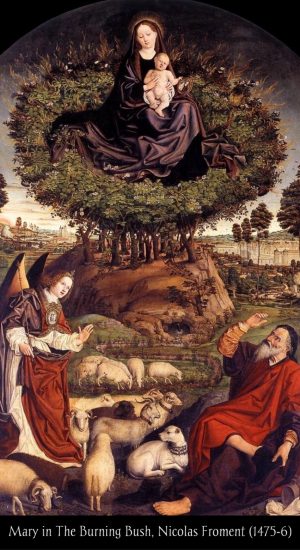
Bible Verses:
1 Peter 3:21
And baptism, which this prefigured, now saves you—not as a removal of dirt from the body, but as an appeal to God for a good conscience, through the resurrection of Jesus Christ,
Romans 5:14
Yet death exercised dominion from Adam to Moses, even over those whose sins were not like the transgression of Adam, who is a type of the one who was to come.
Colossians 2:16–17:
“Therefore do not let anyone judge you by what you eat or drink, or with regard to a religious festival, a New Moon celebration or a sabbath day. These are a shadow of the things that were to come; the reality, however, is found in Christ.”
Church Father Quotes:
Justin Martyr
“[Jesus] became man by the Virgin so that the course which was taken by disobedience in the beginning through the agency of the serpent might be also the very course by which it would be put down. Eve, a virgin and undefiled, conceived the word of the serpent and bore disobedience and death. But the Virgin Mary received faith and joy when the angel Gabriel announced to her the glad tidings that the Spirit of the Lord would come upon her and the power of the Most High would overshadow her, for which reason the Holy One being born of her is the Son of God. And she replied ‘Be it done unto me according to your word’ [Luke 1:38]” (Dialogue with Trypho the Jew 100 [A.D. 155]).
St. Irenaeus of Lyons
“Consequently, then, Mary the Virgin is found to be obedient, saying, ‘Behold, O Lord, your handmaid; be it done to me according to your word.’ Eve, however, was disobedient, and, when yet a virgin, she did not obey. Just as she, who was then still a virgin although she had Adam for a husband—for in paradise they were both naked but were not ashamed; for, having been created only a short time, they had no understanding of the procreation of children, and it was necessary that they first come to maturity before beginning to multiply—having become disobedient, was made the cause of death for herself and for the whole human race; so also Mary, betrothed to a man but nevertheless still a virgin, being obedient, was made the cause of salvation for herself and for the whole human race. . . . Thus, the knot of Eve’s disobedience was loosed by the obedience of Mary. What the virgin Eve had bound in unbelief, the Virgin Mary loosed through faith” (Against Heresies 3:22:24 [A.D. 189]).
“The Lord then was manifestly coming to his own things, and was sustaining them by means of that creation that is supported by himself. He was making a recapitulation of that disobedience that had occurred in connection with a tree, through the obedience that was upon a tree [i.e., the cross]. Furthermore, the original deception was to be done away with—the deception by which that virgin Eve (who was already espoused to a man) was unhappily misled. That this was to be overturned was happily announced through means of the truth by the angel to the Virgin Mary (who was also [espoused] to a man). . . . So if Eve disobeyed God, yet Mary was persuaded to be obedient to God. In this way, the Virgin Mary might become the advocate of the virgin Eve. And thus, as the human race fell into bondage to death by means of a virgin, so it is rescued by a virgin. Virginal disobedience has been balanced in the opposite scale by virginal obedience. For in the same way, the sin of the first created man received amendment by the correction of the First-Begotten” (ibid., 5:19:1 [A.D. 189]).
Tertullian of Carthage
“It was while Eve was still a virgin that the word of the devil crept in to erect an edifice of death. Likewise through a virgin the Word of God was introduced to set up a structure of life. Thus what had been laid waste in ruin by this sex was by the same sex reestablished in salvation. Eve had believed the serpent; Mary believed Gabriel. That which the one destroyed by believing, the other, by believing, set straight” (The Flesh of Christ 17:4 [A.D. 210].
Gregory of Nyssa
“It seems to me that, already, the great Moses knew about this mystery by means of the light in which God appeared to him when he saw the bush burning without being consumed (Ex 3:1). . . What was prefigured at that time in the flame of the bush was openly manifested in the mystery of the Virgin. . . As on the mountain the bush burned but was not consumed, so the Virgin gave birth to the light and was not consumed. Nor should you consider the comparison to the bush to be unfit, for it prefigures the God-bearing body of the Virgin.” -Gregory of Nyssa, On the Birth of Christ 46
Evagrius Ponticus (345-399 A.D.)
“It is necessary to search for allegorical and literal passages pertaining to the praktike, physike, and theologike. If the passage concerns the praktike it is necessary to determine whether it concerns thumos and its effects, or epithumia and its consequences, or whether it concerns the movements of the nous. If the passage pertains to the physike, it is necessary to note whether it reveals a doctrine concerning nature, and which one. Or if it is an allegorical passage concerning theologike it should be determined as far as possible whether it reveals the doctrine of the Trinity […].” -Gnostikos 18
Biblical Typologies→


